
Medieval
Brooches & Badges
MATERIALS - MARRIAGE BROOCHES - RING BROOCHES
- CLOAK CLASPS - PILGRIM BADGES - SECULAR BADGES
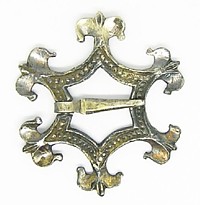 One
of the most constantly depicted pieces of jewellery over the entire
of the middle ages, is the brooch. Brooches were used as wedding
gifts, to close cloaks, at the shoulders of mantles, to pin paternosters
to clothing and as markers of visits to holy places in the form
of pilgrim badges. One
of the most constantly depicted pieces of jewellery over the entire
of the middle ages, is the brooch. Brooches were used as wedding
gifts, to close cloaks, at the shoulders of mantles, to pin paternosters
to clothing and as markers of visits to holy places in the form
of pilgrim badges.
Artifacts have also been
found over a wide expanse of time periods and countries- from
the viking and dark ages to the late renaissance. Many were simple
in their design, although many of immense beauty and excellent
workmanship have been found.
The brooch from The
Gilbert Collection shown at right is from 14th century
France and is made of silver gilt. It has a quatrefoil design
with fleur-de-lys at the terminals and would have been worn by
an Abbess or rich noble woman. At 4cm across, it is quite large
for the average medieval brooch. 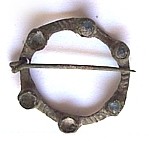
The ring brooch shown at
left is dated to the 14th century from England and has three remaining
glass-paste blue stones. It is the size of a man's thumbnail,
and still has traces of gold gilding remaining. It is also from
my own personal collection.
Materializing Resistant
Identities among the Medieval Peasantry is an article from
2009 which looks at archaeological finds from rural villages throughout
England, such as Wharram Percy and Bolton. The author, Sally V.
Smith, looks at the dress accessories found at these sites and
burial places. It includes brooches, buckles and pins.
Her research finds that few
of these items were made of poor quality metal. Surprisingly,
most were copper or iron, with one made from gold. She concludes
that peasants were not choosing items made using the cheapest
metals available. Over half were decorated or purely decorative
providing an interesting contrast to the common perception of
peasants in ragged clothing laboring in the fields.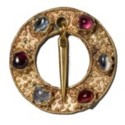
It is possible that these
items were not worn daily and saved for best or special occasions
the same way that special jewellery is reserved for special occasions
today. One would hardly wear a diamond tiara to work or shopping
these days and it is possible that the same attitude was prelevant
then also.
What is interesting to note
is that they possessed these items at all. It is possible that
these items were acquired for a life milestone such as a marriage,
but without documented evidence, it is difficult to say for certain.
Pictured at right is a beautiful ring brooch with gemstones set
into it from the middle Rhine region of Germany which dates between
1340 and 1349.

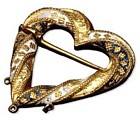 Materials Materials
Brooches could be copper-alloy, gold or silver or silver gilt
or pewter for the lower classes. The gems set into them reflected
the status and wealth of the wearer, although it was not uncommon
for brooches and other jewellery to use fake gemstones made of
glass-paste instead of real ones.
The ornate brooch at the
left is from the mid-15th century collection, the Fishpool Hoarde.
It is enameled with blue and white enamel with tiny gold flowers.
It has three circles near the bottom of the base of the heart
which may have been for pendants.

Marriage
Brooches
Along with wedding rings, wedding brooches were a traditional
gift from a man to his bride-to-be. It was not only a token of
his love but a marriage brooch provided her with an icon befitting
her new status as a wife. It also idealised her 'cleanliness of
heart' as a married woman.
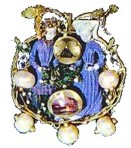 The
brooch shown at left is made in Burgundy or Germany and is dated
at 1430. It is constructed from gold and is enameled and set with
precious stones- pearls, a diamond above and a ruby below. It
shows a man and a woman together both wearing blue robes, the
colour associated with consistency, and a woven fence around them.
The clear white of the diamond represented the durability of love
while the ruby represented love's fiery force. The
brooch shown at left is made in Burgundy or Germany and is dated
at 1430. It is constructed from gold and is enameled and set with
precious stones- pearls, a diamond above and a ruby below. It
shows a man and a woman together both wearing blue robes, the
colour associated with consistency, and a woven fence around them.
The clear white of the diamond represented the durability of love
while the ruby represented love's fiery force.
Johannes de Hauville wrote
of a marriage brooch when he penned these lines:
"My bride shall
wear a brooch, a witness to her modesty and proof that hers
will be a chaste bed. It will shut up her breast and thrust
back and intruder, preventing its closed approach from gaping
open and the entrance to her bosom being cheapened by becoming
a beaten path for any traveler and an adulterous eye from
tasting what delights the honorable caresses of a husband."

Cloak
Clasps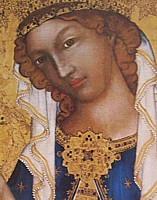
Brooches worn as cloak clasps were of two distinctly differing
kinds.
The first style was a largish
ornate single brooch which held the cloak closed at the centre
of the throat. An example of the single-clasp style can be seen
in the detail of the image at right Virgin and Child from
Prague in 1345-1350. It shows an exceptionally large and elaborate
gold brooch with gemstones set in a pattern radiating from the
centre. Most brooches were substantially smaller than this, but
the Virgin Mary is often shown in clothing and dress accessories
which were royal, and not a good indication of daily wear.
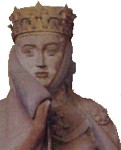 The
second style of cloak clasps, which were also usually very ornate,
were a jewelled pair of brooches and were used by the wealthy
to fasten their mantles. These were worn roughly at collarbone
height and fastened with a cord which was often shown in artworks
and sculptures as being tasseled. The
second style of cloak clasps, which were also usually very ornate,
were a jewelled pair of brooches and were used by the wealthy
to fasten their mantles. These were worn roughly at collarbone
height and fastened with a cord which was often shown in artworks
and sculptures as being tasseled.
The sculpture from the Namburg
Cathedral in Germany at left is from the pair Count Eckkhard
II and Uta is dated from 1250 and shows a large, jewel set
brooch which is joined to a band which runs across the wearer's
chest and to another identical brooch on the other side.

Ring
Brooches 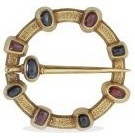
Plain circular ring brooches were used for their simple design
and practical use throughout many stages of history by both men
and women. They could be plain, have inscriptions or be set with
precious and semi-precious jewels. Many were given as gifts and
were designed to be worn at the breast.
The ring brooch shown at
right is from the Museum of London's collection and is dated at
the 13th Century. It is defined as a Lovers Brooch and
is made from gold and set with alternating rubies and sapphires.
It is believed to be either English or French manufacture.
The message on the back translates
to I am here in place of the friend I love.

The double ring brooch shown
above is made from gold as has green stones and a large sapphire
set into it. It is from England from approximately 1300 and it
would have been worn across the front of a cloak- each ring brooch
fastening one side of the mantle and the rigid setting across
the chest would be instead of the usual cord fastening.

Pilgrim
Badges
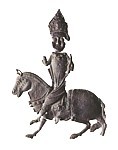 Pilgrim
badges were one of the most popular types of souvenir in the medieval
period. Badges were produced for two main reasons- to raise extra
revenue for the shrine or church and to avert pilfering from holy
places. Pilgrim
badges were one of the most popular types of souvenir in the medieval
period. Badges were produced for two main reasons- to raise extra
revenue for the shrine or church and to avert pilfering from holy
places.
It seems that pilgrims who
were keen to take a souvenir back home were less likely to steal
from relics if they were able to buy a badge instead, especially
as it was thought that a badge bought at a particular shrine retained
the properties of the saint which was honored there.
 Mostly,
pilgrim badges were worn prominently attached to hoods, bags and
sewn onto hats. Mostly,
pilgrim badges were worn prominently attached to hoods, bags and
sewn onto hats.
Pilgrim badges were made
of an alloy of lead and tin or pewter. These were cast in moulds
and were often cheaply made with the quality of the pewter varying
greatly. Badges favoured by women featured Saint Katherine, patron
saint of learning for young women, or of the Virgin Mary.
The badge at left depicts
the head of John the Baptist, patron saint of Perth in Amiens,
France. It is completely intact, with four rings which enabled
the badge to be sewn onto the pilgrim's hat or cloak. The back
is decorated with a crucifix design and the inscription on the
front identifies it as the sign of John the Baptist.

Secular
Badges
Secular badges were similar to pilgrim badges in that they were
made from pewter and cheaply made. Unlike pilgrim badges, they
were not of a religious nature and covered more mundane topics,
like hounds, flowers, hearts with love slogans and an eye-watering
range of carnival badges which we see today as X-rated.
Medieval people, however,
appeared to be hilariously fond of them.

Copyright
© Rosalie Gilbert
All text & photographs within this site are the property of
Rosalie Gilbert unless stated.
Art & artifact images remain the property of the owner.
Images and text may not be copied and used without permission.
|